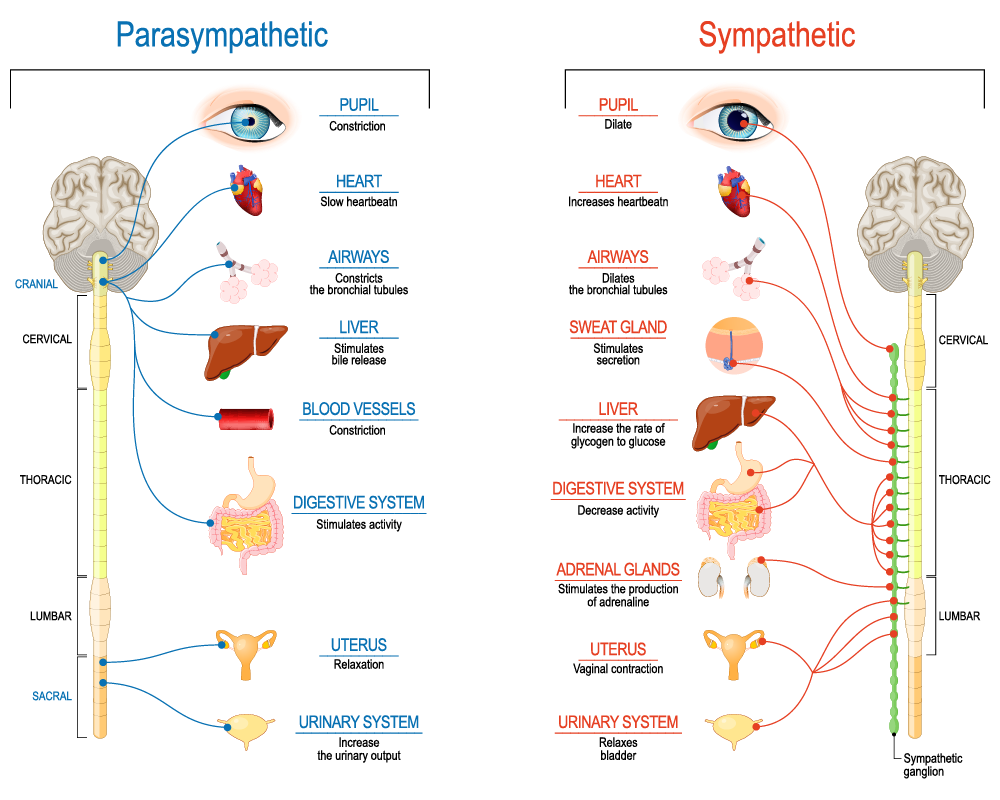THE VAGUS NERVE & DIAPHRAGM
So first off, what is the vagus nerve?
Briefly put, the vagus nerve is one of the most important nerves responsible for calming your body down!
Basic Anatomy:
The Vagus Nerve is the longest, most complex cranial nerve, which is why it’s derived from the Latin word vagus, meaning “vagrant, wanderer”. It innervates the muscles of the throat (pharynx and larynx) and the organs of respiration (lungs), circulation (heart), digestion (stomach, liver, pancreas, duodenum, small intestine, & the ascending and transverse sections of the large intestine), and elimination (kidneys).
So how does it fit in with stress? Well first off, let’s look at the autonomic nervous system.
The autonomic nervous system is responsible for involuntary physiological processes, such as your heart rate, digestion, and pupil dilation. It comprises of two parts:
Parasympathetic nervous system aka ‘rest & digest’. Your body is in RELAXATION MODE
Sympathetic nervous system aka ‘fight or flight’. Your body is in STRESS MODE
An optimal, flexible nervous system would be able to switch between these two modes efficiently to meet different needs. For example, if you are about to play a basketball game, your sympathetic aka ‘fight or flight’ nervous system would dominate, giving you the ready to act, react or perform. Or if it’s time for bed, your parasympathetic aka ‘rest & digest’ mode would dominate to calm you down ready to sleep.
The problem occurs when a person is chronically stressed or overloaded - physically or mentally. The natural interplay between the two systems can be disrupted, and the body can get stuck in a sympathetically dominant fight state, even when the person is resting.
This can lead to an array of physical & mental health conditions as stress hormones are pumped out by your pituitary gland at a rate higher than normal. Symptoms of an overactive sympathetic nervous system over a prolonged period of time can include heart palpitations, gut issues, anxiety, insomnia, ulcerative colitis & thyroid issues to name a few.
The good news is that we can dampen this hyper stress state by indirectly stimulating the vagus nerve! The vagus nerve is actually the main circuitry to the parasympathetic nervous system. So by stimulating this nerve, we can facilitate a physiological relaxation response in the body.
So how does this work? The vagus nerve runs through the esophageal hiatus of the diaphragm, which is our main respiratory muscle (read more on the connection of stress & the diaphragm here). So any movement of the diaphragm stimulates the vagus nerve, which in turn stimulates the parasympathetic response. That means the more the diaphragm moves, the more stimulation to the parasympathetic nervous system! And the more your body can switch off it’s hyper stressed state & into relaxation mode!
So then, how can we get the diaphragm to move more?
Deep diaphragmatic breathing (read more on my blog post here)
Laughter (hence the saying Laughter is the best medicine!)
Singing
Stretching your hip flexors (via it’s connection through the Deep Front Line)
Yoga
Myofascial release through the diaphragm & hip flexors (we offer this service under Physiotherapy- you can book here)
Improve your posture - hunched over posture compresses your trunk, inhibiting optimal movement of the diaphragm.
I hope this article gave you an insight on how we can use our body’s movements for our advantage! I welcome your comments & thoughts below :)



